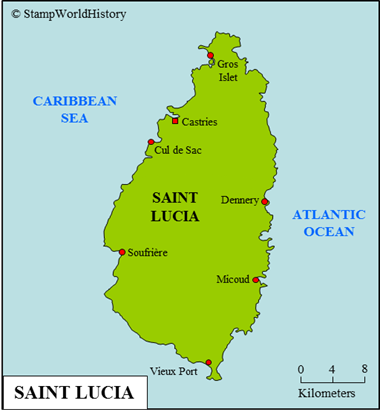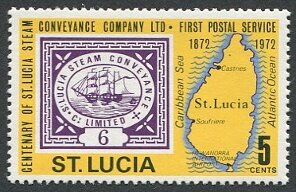
Saint Lucia
British colony

Saint Lucia
Independent
Quick reference
General issues: British colony 1860-1958, Province West Indies Federation 1958-1962, British colony 1962-1967, Associated state 1967-1979, Independent within the British Commonwealth 1979-Present
Country name on general issues: St. Lucia, Saint Lucia
Special issues: St. Lucia Steam Conveyance Company 1873
Currency: 1 Pound = 20 Shilling, 1 Shilling = 12 Pence 1860-1951, 1 Dollar = 100 Cents 1951-Present
Population: 49 000 in 1900, 183 600 in 2014
Political history Saint Lucia
Saint Lucia is located in the Caribbean as one of the Lesser Antilles – for the exact location, please refer to the map of the Caribbean. Prior to colonization, the island was inhabited by the Amerindian Carib people – a people found on many of the Lesser Antilles. The first European sighting is disputed and had possibly been around 1500. The first attempts at colonization are made in the 17th century by the British and the French and met with strong opposition from the Caribs. Throughout the 17th and 18 centuries, Saint Lucia would be disputed between the British and the French – possession of the island going back and forth between the two nations 14 times. British sovereignty was finally recognized in 1814.
Established as a British colony in 1814, Saint Lucia, in 1833, was made part of the Windward Islands colony – the federal colony that grouped together the British possessions in the Windward Islands. The Windward Islands colony was – unlike the Leeward Islands – a loose federation in which the constituent parts had their own parliaments and legislation. The Windward Islands was dissolved in 1956. Shortly after, between 1958 and 1962, Saint Lucia joined the West Indies Federation – a short lived federation of most of the British possessions in the Caribbean. In 1967, Saint Lucia became self governing as an associated state, and in 1979 Saint Lucia gained full independence within the British Commonwealth. Thus, Saint Lucia, currently, is a parliamentary democracy with the Queen of Great Britain as head of state.
Economically, Saint Lucia was developed as a plantations colony, first by the French in the second part of the 18th century, and next by the British, with sugar cane as the most important crop. To man the plantations, slaves were brought to the island who would soon form the majority of the population. As sugar cane went into decline in the 19th century, bananas became the most important crop in the 20th century. In modern day Saint Lucia, tourism is the mainstay of the economy, accounting for 65% of the GDP. On the United Nations Human Development Index, Saint Lucia ranks as a High Development Country. The majority of the population is black – 85%. The long influence of the French is reflected in the fact that – although English is the official language – 95% of the population also speak French Creole.
Postal history Saint Lucia
The first stamps used in Saint Lucia were the general issues of Great Britain. These were used between 1858 and 1860. Saint Lucia issued its first stamps in 1860 – the first issue, and subsequent issues until 1883, are of a design unique for Saint Lucia, showing the portrait of Queen Victoria. These first issues have no denomination – the denomination being determined by the stamp color. Since 1883, the issues are of designs common to the British colonies. Sets issued in 1936 and 1938 are again – although in a style common to the British colonies – of designs specific for Saint Lucia. Saint Lucia has joined in a number of omnibus issues for the British colonies. Of interest are the first, provisional, postage due stamps issued in 1931 – a surprisingly primitive issue with hand stamped control numbers. In the modern era, Saint Lucia has issued a blend of stamps with themes of national interest and themes of interest for the thematic collectors market.
The Michel catalog refers to stamps issued by the St. Lucia Steam Conveyance Company in 1873. The shipping company provided a postal service between the different ports on the island, since 1872, until liquidated in 1890. The stamps issued are rare and sell for high prices. In 1972, Saint Lucia issued a set to commemorate the service – depicting the stamps issued.
Album pages
← Previous page: Saint Kitts, Nevis & AnguillaNext page: Saint Vincent →





